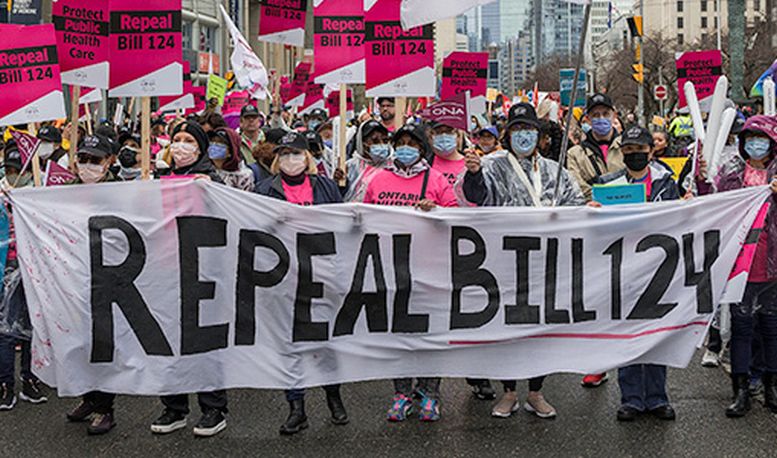Court Rules Wage Cap Law Illegal
Two weeks ago Doug Ford suffered the first major defeat of his time in office when the strike movement of 55,000 CUPE education workers and the threat of an Ontario-wide general strike forced him to withdraw pre-emptive back-to-work legislation. That was the first black eye. The second one came on November 29, via a judicial decision.
Unions Go to Court
Bill 124, introduced in 2019, and going by the Orwellian name, Protecting a Sustainable Public Sector for Future Generations Act, had unilaterally imposed a one percent cap on annual pay increases in the public sector for a period of three years. The legislation, introduced with the excuse of saving costs, faced increasing criticism during the COVID-19 pandemic as front-line health care workers in overwhelmed hospitals and long-term care homes were subject to the cap. That didn’t seem to bother Ford. He thought a one-off $2,500 retention bonus to nurses would be enough to do the trick. It wasn’t.
In November 2019, the Ontario teacher unions and other public sector unions launched a court challenge against Bill 124. Three years later, came the decision: Justice Koehnen ruled that the passage of Bill 124 infringed upon union members’ right to freedom of association under the Charter. He stated that “the Charter protects not just the right to associate, but also the right to a meaningful process in which unions can put on the table those issues that are of concern to workers and have them discussed in good faith. Legislation that takes issues off the table interferes with collective bargaining.”
Justice Koehnen also noted in his decision that the Ontario government was imposing a limit of one percent on wage increases because it feared that not setting that legal limit would lead union members to exercise their constitutionally protected right to strike. He noted that, “Although inconvenient, the right to strike is a component of a free and democratic society.”
Getting Results — Courts vs Militant Action
Justice Koehnen said this bill differed from wage cap legislation introduced by other governments because the financial situation wasn’t as severe. He wrote, “Ontario was not facing a situation in 2019 that justified an infringement of Charter rights. Unlike other cases that have upheld wage restraint legislation, Bill 124 sets the wage cap at a rate below that which employees were obtaining in free collective bargaining negotiations.” The door has now been opened for unions to seek billions of dollars in back pay to make up for lost wages that should have been awarded had Bill 124 not been in place. Unions representing hospital and long-term care workers, who are barred from striking by Ontario law, can return to arbitration to get a deal.
However, note the differences between how the two black eyes were inflicted — the first one, withdrawal of the back to work legislation was achieved through workers taking direct strike action and by refusing to be intimidated by a bully boy premier trying to use the full powers of the state. The time taken to black that eye: one week. For the second one, it was much more drawn out: protests, lobbying of MPPs, sending emails, social media posts, ending up finally with the union lawyers going to court. The time taken to blacken the second eye: 3 years. The Ford government is likely to appeal the decision, dragging it out for more years.
Doug Ford: No Friend of Workers
In the 2022 elections, eight unions backed Doug Ford including LiUNA, the International Brotherhood of Electrical Workers, the International Brotherhood of Boilermakers and the Ontario Pipe Trades Council. This helped Ford’s false claims of “working for workers.”
The reality of Ford’s and the Conservative’s agenda towards workers was clear before the recent short-lived back-to-work legislation. They brought in Bill 124 in 2019, in 2018 they scrapped the agreed increase in the minimum wage to $15 along with other attacks on workers, and attacked teachers and education in 2019. On top of these is the total failure to protect seniors and workers during COVID.
With union leaders so lacking in basic class understanding, it is no wonder that workers are suffering falling living standards.
Court’s dangerous decision
Using the courts to defend workers’ rights is a risky business, as the law isn’t an objective institution that can be depended upon to take a dispassionate view of the conflicts between labour and capital. Justice Koehnen said that Bill 124 differed from wage cap legislation introduced by other governments because the financial situation wasn’t as severe. “Ontario was not facing a situation in 2019 that justified an infringement of Charter rights,” he wrote in his decision. In other words, if the financial situation had been deemed “severe,” the decision could have gone in favour of the government.
Who decides on “severe?” It is unlikely that a judge would consider the attack on workers’ living standards due to inflation as severe. It is more likely a judge would look at the province’s balance sheet and the state of the finances depends on political decisions. Ontario is projecting a budget deficit of $12.9 billion in 2022-23. However, the government’s fall economic statement gives $675 million in income tax relief to businesses over the next three years. They will also ease the rules on corporate income tax, allowing an estimated 5,500 companies to save around $185 million. These two actions give $860 million to business. It is a political choice that benefits business, to the cost of workers and public services.
How to Best Defend Workers’ Rights
Socialists do not have a principled position with using the capitalist courts to defend workers’ rights. If legal action can bring governments and employers to heel, that’s fine. However, even when the courts do side with labour, the time between the unions initiating the process and the judgment coming down can be very long. In 2016 the British Columbia Teachers’ Federation won a landmark ruling against the BC government at the Supreme Court of Canada on the issue of class size and staffing levels in schools. However, the whole process took nearly 15 years from beginning to end. A short, sharp strike might well have dealt with the issue in a short period of time and without the cost of the lawyers.
The Bill 124 court decision will probably play into the hands of union leaders who have got out of the habit (if they were ever in the habit) of class struggle militancy. Judicial methods can form a useful supplementary strategy to the fight on the picket lines but the lessons of the CUPE strike are that the most effective way of struggle, the one that builds class consciousness and confidence, is the tried and trusted one of the strike.




